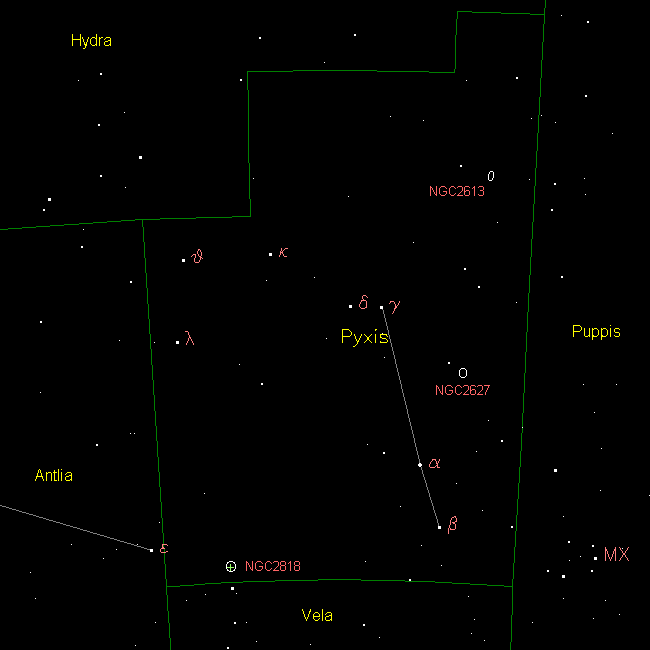[/caption]
The constellation of Pyxis is located south of the ecliptic plane. At one time its stars were considered part of the ancient constellation of Argo Navis as the “mast” of the great ship. In later years, Argo Navis was split into three seperate constellations – Puppis, Vela and Carina – by Nicolas Louis de Lacaille. At the time he named the Pyxis group of stars Pyxis Nautica – the “Mariner’s Compass”. It was suggested by John Herschel the group of stars be named Malus, the “Mast”, but the suggestion was not followed. When the constellation was officially recognized and placed permanently by the IAU, the name was shortened to just Pyxis. It covers 221 square degrees of sky and ranks 65th in size. Pyxis contains 3 main stars in its asterism and has 10 Bayer Flamsteed designated stars within its confines. It is bordered by the constellations of Hydra, Puppis, Vela and Antlia. Pyxis is visible to all observers located at latitudes between +50° and ?90° and is best seen at culmination during the month of March.
As a section of the great ship Argo Navis, the mythology of Pyxis is the legend of the great sea and the adventures of Jason and the Argonauts. The great galley was built under the orders of the goddess Athene, where she then fitted a beam into the prow from the oracle of Zeus. On board was a crew of Greek heroes, including such notable mythological figures such as Hercules, Castor and Pollux. Of course, their journeys were legendary, and after having acquired the golden fleece they dedicated the ship to the sea god Poseidon, who immortalized it in the stars and the first of the ocean-going vessels. Due to it’s enormous size, early cartographers often had difficulty portraying it on star charts and its magical prow had disappeared. The mariner’s compass, the constellation of Pyxis, was also once considered a part of Argo Navis, too… But has also been divided away with time. Small wonder since the magnetic compass was virtually unknown to the ancient Greeks! However, we cannot default Lacaille for his love of scientific instruments and his wish to immortalize them in the stars. Where charts did not depict the mast, Lacaille figured it was anchored in a reef and called his new constellation “la Boussole” to represent a marine compass.
Let’s begin our binocular tour of Pyxis with its brightest star – Alpha – the “a” symbol on our map. Alpha Pyxidis is 850 light years away from Earth and appears quite dim because of interstellar dust. In reality, this hot, blue-white giant star is about 18,000 times brighter than our own Sun and about 8 times larger. Hiding inside a circumstellar shell, Alpha might very well be a Beta Cephi variable star!
For large binoculars and small telescopes, try your hand at open cluster and planetary nebula combination, NGC 2818 (RA 9 : 16.0 Dec -36 : 37). At magnitude 8 and 9 arc minutes in size, it will be a challenge for smaller optics, but a fun one! The planetary nebula is very unique due to its association with a Population I open star cluster. This means the cluster itself is overabundant in HII regions and studies have shown that it is associated with the cluster and not just a chance alignment. Large telescopes will pick up lobes in the planetary nebula structure and a faint green coloration, while the cluster structure is very open and scattered.
Another challenging galactic star cluster for binoculars and small telescopes is NGC 2627 (RA 8 : 37.3 Dec -29 : 57). At magnitude 8 and 11 arc minutes in size, it makes a slightly better presentation with more compression and stars. While it will only be a hazy patch in binoculars, larger telescopes can expect to resolve out around 40 or so stars in the rich field and pick out some color in this intermediate aged open wonderland!
How about a telescope challenge? Then try your hand at NGC 2613 (RA 8 : 33.4 Dec -22 : 58). This 10th magnitude spiral galaxy is surprisingly large, bright, and overlooked! Located about 60 million light years away from our solar system, this under-rated jewel is a case study in radial velocity dispersions and stellar kinematics. According to research, massive edge-on spiral galaxy NGC 2613 shows evidence of supershells which, if confirmed, would be among the largest known!
Sources:
Wikipedia
University of Wisconsin
Chart Courtesy of Your Sky.

